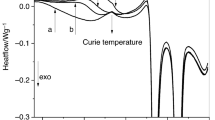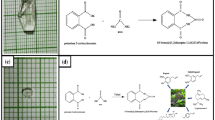Abstract
A series of crystalline thiazoloquinolinium iodides has been studied using a combination of thermal analysis, mass and Raman spectroscopy techniques. The influence of composition and polyiodide anion stoichiometry on the features of iodine loss has been revealed. It has been shown that the existence of a bound diiodine molecule in a polyiodide chain leads to significant decrease in melting point and decomposition temperatures in comparison with corresponding mono- and triiodide salts. The loss of the diiodine molecule from the complex polyiodide proceeds independently, without decomposition of the organic cation, while the release of diiodine from the triiodide anion goes simultaneously with thermal decomposition of the cation. In addition, the decomposition processes on the surface of the thiazoloquinolinium polyiodide crystal have been investigated during sample storage. Iodine loss and formation of more stable triiodide have been proved using Raman spectroscopy data.






Similar content being viewed by others
References
Svensson PH, Kloo L. Synthesis, structure, and bonding in polyiodide and metal iodide-iodine systems. Chem Rev. 2003;103:1649–84.
Yamanaka N, Kawano R, Kubo W. Dye-sensitized TiO2 solar cells using imidazolium-type ionic liquid crystal systems as effective electrolytes. J Phys Chem B. 2007;111:4763–9.
Fei Z, Kuang D, Zhao D, Klein C, Ang WH, Zakeeruddin SM, Grätzel M, Dyson PJ. A supercooled imidazolium iodide ionic liquid as a low-viscosity electrolyte for dye-sensitized solar cells. Inorg Chem. 2006;45:10407–9.
Waentig L, Jakubowski N, Hayen H, Roos PH. Iodination of proteins, proteomes and antibodies with potassium triodide for LA-ICP-MS based proteomic analyses. J Anal At Spectrom. 2011;26:1610–8.
Moulay S. Molecular iodine/polymer complexes. J Polym Eng. 2013;33:389–443.
Kaiho T. Iodine chemistry and applications. New York: Wiley; 2014.
Miyao K, Funabiki A, Takahashi K, Mochida T, Uruichi M. Reversible iodine absorption of nonporous coordination polymer Cu(TCNQ). New J Chem. 2014;38:739–43.
Mukherjee A, Tothadi S, Desiraju GR. Halogen bonds in crystal engineering: like hydrogen bonds yet different. Acc Chem Res. 2014;47:2514–24.
Reiss GJ, Engel JS. Crystal engineering of a new layered polyiodide using 1,9-diammoniononane as a flexible template cation. Z Naturforsch. 2004;59b:1114–7.
Subashini A, Rajarajan K, Sagadevan S, et al. Preparation and characterization of a bis thiourea sodium iodide (BTSI). J Therm Anal Calorim. 2018;131:2179.
Tebbe KF, Farida T, Stegemann H, Fullbier H. Untersuchungen an Polyhalogeniden. XXIII. Kristallstrukturen der N‐Alkylurotropiniumtriiodide UrRI3 mit R = Methyl, Ethyl, n‐Propyl und n‐Butyl. Z Anorg Allg Chem. 1996;622:525.
Tebbe KF, Loukili R. Über das Dimethyl(n‐propyl)phenylammoniumtriiodid n‐PrMe2PhNI3 und die Reihe der Dimethyl(isopropyl)phenylammoniumpolyiodide i‐PrMe2PhNIx mit x = 3, 5, 7, 8, 9. Z Anorg Allg Chem. 1998;624:1175.
Tebbe KF, Nagel K. Untersuchungen an Polyhalogeniden. XXVI [1]. Über NPropylurotropiniumpolyiodide UrPrIx mit x = 5 und 7: Strukturelle Charakterisierung eines Pentaiodids und eines Heptaiodids. Z Anorg Allg Chem. 1996;622:1323.
Bartashevich EV, Yushina ID, Vershinina EA, Slepukhin PA, Kim DG. Complex structure tri- and polyiodides of iodocyclization products of 2-allylthioquinoline. J Struct Chem. 2014;55:112–9.
Iwata R, Kitagawa K, Zhang NY, Wu B, Inagaki C. Non-steroidal anti-inflammatory drugs protect amyloid beta protein-induced increase in the intracellular Cl-concentration in cultured rat hippocampal neurons. Neurosci Lett. 2004;367:156–9.
Metrangolo P, Resnati G. Halogen donding II: impact on materials chemistry and life sciences. Berlin: Springer; 2015.
Desiraju GR, Ho PS, Kloo L. Definition of the halogen bond (IUPAC Recommendations 2013). Pure Appl Chem. 2013;85:1711–3.
Politzer P, Murray JS, Clark T. Halogen bonding: an electrostatically-driven highly directional noncovalent interaction. Phys Chem Chem Phys. 2010;12:127748–57.
Gordon ER, Walsh RB, Pennington WT, Hanks TW. Syntheses and structures of two acridine orange polyiodide salts. J Chem Crystallogr. 2003;33:385–90.
Bartashevich EV, Nasibullina SE, Bol’shakov OI, Tsirelson VG. Exploring heterocyclic cations ability to form the iodide–iodine halogen bond: case study of chalco-genazolo(ino)quinolinium crystals. Struct Chem. 2016;27:305–13.
Das GC, Das B, Sarma NS, Medhi OK. Synthesis, structure and properties of cetyltrimethylammonium polyiodides. Polyhedron. 2012;37:14–20.
Wang Y, Xue Y, Wang X, Cui Z, Wang L. The stable polyiodides: experimental and theoretical studies of formation mechanism. J Mol Struct. 2014;1074:231–9.
Yushina ID, Rudakov BV, Krivtsov IV, Bartashevich EV. Thermal decomposition of tetraalkylammonium iodides. J Therm Anal Calorim. 2014;118:425–9.
Aliev ZS, Musayeva SS, Imamaliyeva SZ, et al. Thermodynamic study of antimony chalcoiodides by EMF method with an ionic liquid. J Therm Anal Calorim. 2018;133:1115.
Sawicka M, Storoniak P, Skurski P, Błazejowski J, Rak J. TG-FTIR, DSC and quantum chemical studies of the thermal decomposition of quaternary methylammonium halides. Chem Phys. 2006;324:425–37.
Keshavarz MH, Mousaviazar A, Hayaty M. A novel approach for assessment of thermal stability of organic azides through prediction of their temperature of maximum mass loss. J Therm Anal Calorim. 2017;129:1659.
Deplano P, Ferraro JR, Mercuri ML, Trogu EF. Structural and Raman spectroscopic studies as complementary tools in elucidating the nature of the bonding in polyiodides and in donor-I2 adducts. Coord Chem Rev. 1999;188:71–95.
Kim DG. Synthesis and halocyclization of 2-alkenylthioquinolines. Chem Heterocycl Compd. 2008;11:1664–8.
Bartashevich EV, Yushina ID, Stash AI, Tsirelson VG. Halogen bonding and other iodine interactions in crystals of dihydrothiazolo(oxazino)quinolinium oligoiodides from the electron-density viewpoint. Cryst Growth Des. 2014;14:5674–84.
Grafe-Kavoosian A, Nafepour S, Nagel K, Tebbe KF. Studies on polyhalides, XXXVI on the octaiodide ion I82−: preparation and crystal structure of [(Crypt-2.2.2)H2]I8, of [Ni(phen)3]I8·2CHCl3 and of the (N-alkylurotropinium)octaiodides (UrR)2I8 with R = methyl and ethyl. Z Naturforsch B Chem Sci. 1998;53:641.
Bertolotti F, Shishkina AV, Forni A, Gervasio G, Stash AI, Tsirelson VG. Intermolecular bonding features in solid iodine. Cryst Growth Des. 2014;14:3587–95.
Topol LE. Thermodynamic studies in the tetramethylammonium iodide-polyiodide and tetraethylammonium iodide-polyiodide system. Inorg Chem. 1971;10:736.
Do K, Klein TI, Pommerening CA, Sunderlin LS. A new flowing afterglow-guided ion beam tandem mass spectrometer. Applications to the thermochemistry of polyiodide ions. J Am Soc Mass Spectrom. 1997;8:688–96.
Landrum GA, Goldberg N, Hoffmann R. Bonding in the trihalides (X3−), mixed trihalides (X2Y−) and hydrogen bihalides (X2H−). The connection between hypervalent, electron-rich three-center, donor-acceptor and strong hydrogen bonding. Dalton Trans. 1997;19:3605–13.
Chase MW. NIST-JANAF themochemical tables, fourth edition. J Phys Chem Ref Data Monogr. 1998;9(1):1951.
Yushina ID, Kolesov BA, Bartashevich EV. Raman spectroscopy study of new thia- and oxazinoquinolinium triodides. New J Chem. 2015;39:6163–70.
Acknowledgements
This work was supported by grant of Ministry of Education and Science of the Russian Federation (Award No 4.1157.2017/4.6) and by the Government of the Russian Federation, Act 211, contract No. 02.A03.21.0011.
Author information
Authors and Affiliations
Corresponding author
Additional information
Publisher's Note
Springer Nature remains neutral with regard to jurisdictional claims in published maps and institutional affiliations.
Electronic supplementary material
Below is the link to the electronic supplementary material.
Rights and permissions
About this article
Cite this article
Yushina, I.D., Pikhulya, D.G. & Bartashevich, E.V. The features of iodine loss at high temperatures. J Therm Anal Calorim 139, 1017–1023 (2020). https://doi.org/10.1007/s10973-019-08442-y
Received:
Accepted:
Published:
Issue Date:
DOI: https://doi.org/10.1007/s10973-019-08442-y




